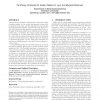Free Online Productivity Tools
i2Speak
i2Symbol
i2OCR
iTex2Img
iWeb2Print
iWeb2Shot
i2Type
iPdf2Split
iPdf2Merge
i2Bopomofo
i2Arabic
i2Style
i2Image
i2PDF
iLatex2Rtf
Sci2ools
SENSYS
2004
ACM
2004
ACM
Hardware design experiences in ZebraNet
The enormous potential for wireless sensor networks to make a positive impact on our society has spawned a great deal of research on the topic, and this research is now producing environment-ready systems. Current technology limits coupled with widely-varying application requirements lead to a diversity of hardware platforms for different portions of the design space. In addition, the unique energy and reliability constraints of a system that must function for months at a time without human intervention mean that demands on sensor network hardware are different from the demands on standard integrated circuits. This paper describes our experiences designing sensor nodes and low level software to control them. In the ZebraNet system we use GPS technology to record fine-grained position data in order to track long term animal migrations [14]. The ZebraNet hardware is composed of a 16-bit TI microcontroller, 4 Mbits of off-chip flash memory, a 900 MHz radio, and a low-power GPS chip....
| Added | 30 Jun 2010 |
| Updated | 30 Jun 2010 |
| Type | Conference |
| Year | 2004 |
| Where | SENSYS |
| Authors | Pei Zhang, Christopher M. Sadler, Stephen A. Lyon, Margaret Martonosi |
Comments (0)

